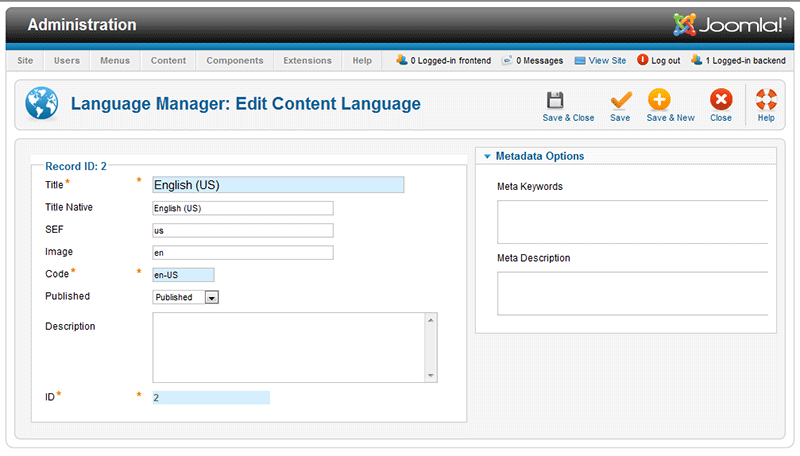Help16:Extensions Language Manager Edit
From Joomla! Documentation
How to Access
Select Extensions → Language Manager from the drop-down menu on the back-end of your Joomla! installation or click the icon Language in the control center. Under the content tab click on the language to edit.
Description
In the Language Manager: Edit Content Language you can set the title, SEF, image, code, and description of the installed langauges. You may also update or add meta keywords and description.
Screenshot
Details
- Title. The name of the language as it will appear ion the lists.
- Title Native. Lenguag title IN the native language.
- SEF. SEF for this language. If 'en' is used then it will be added after the site URL. Example: http://mysite.com/en. Note: The prefix must be unique over all the languages.
- Image. Name of the image file for this language when using the "Use Image Flags" Language Switcher basic option. Example: If 'en' is chosen, then the image shall be en.gif. Images and CSS for this module are in media/mod_languages/
- Code. Enter here the language tag - example: en-GB for English (UK). This should be the exact prefix used for the language installed or to be installed.
- Published. Available options are published, unpublished, disabled, trash
- Description. Enter a discription for the language
- ID. This is a unique identification number for this item assigned automatically by Joomla!. It is used to identify the item internally, and you cannot change this number. When creating a new item, this field displays 0 until you save the new entry, at which point a new ID is assigned to it.
Toolbar
At the top right you will see the toolbar:
- Save & Close. Saves the item and closes the edit screen.
- Save. Saves the item and stays in the edit screen.
- Save & New. Saves the item and keeps the editing screen open and ready to create another item.
- Close. Returns to the previous screen without saving your work. If you press Close while adding a new item, this new item will not be created. If you were modifying an existing item, the modifications will not be saved.
- Help. Opens this Help Screen.
Site and Administrator Links
At the top left, above the columns, you will see two links as shown below:
- Site. Shows the Languages available for the Front-end of the web site.
- Administrator. Shows the Languages available for the Back-end of the web site. Note that the languages for the Front and Back end can be different.
Quick Tips
- Users can use any Language from the list of installed Languages, either by having it assigned in the User Manager or by filling out a Menu Item Manager - New/Edit - User Form Layout at the Front end. This will cause the Joomla! system prompts to be generated in this Language just for this User. For example, if a User chooses Spanish as their language, then the Search Module will show with prompts in Spanish.
- This User's choice is not affected by the Default Language set for the Front-end.
- Changing a User's Language or the Default Language does not affect the web site's Articles and other content.
- Important: Do not delete the default language files (for example, with FTP). This will create errors on both the Front-end and Back-end.
- Additional Languages can be added using the Extension Manager - Install Screen.
- If desired, you can show the Front-end site in one Language and show the Back-end administration pages in a different Language. Also, individual articles can be configured to use a different language in the Advanced Parameter pane when editing the Article.
Related Information
- To install more Languages: Extension Manager - Install Screen
- To uninstall a Language: Extension Manager - Manage
- To change the Language for a User: User Manager - New/Edit
- To set the Language of an Article: Article Manager - New/Edit - Parameters - Advanced

